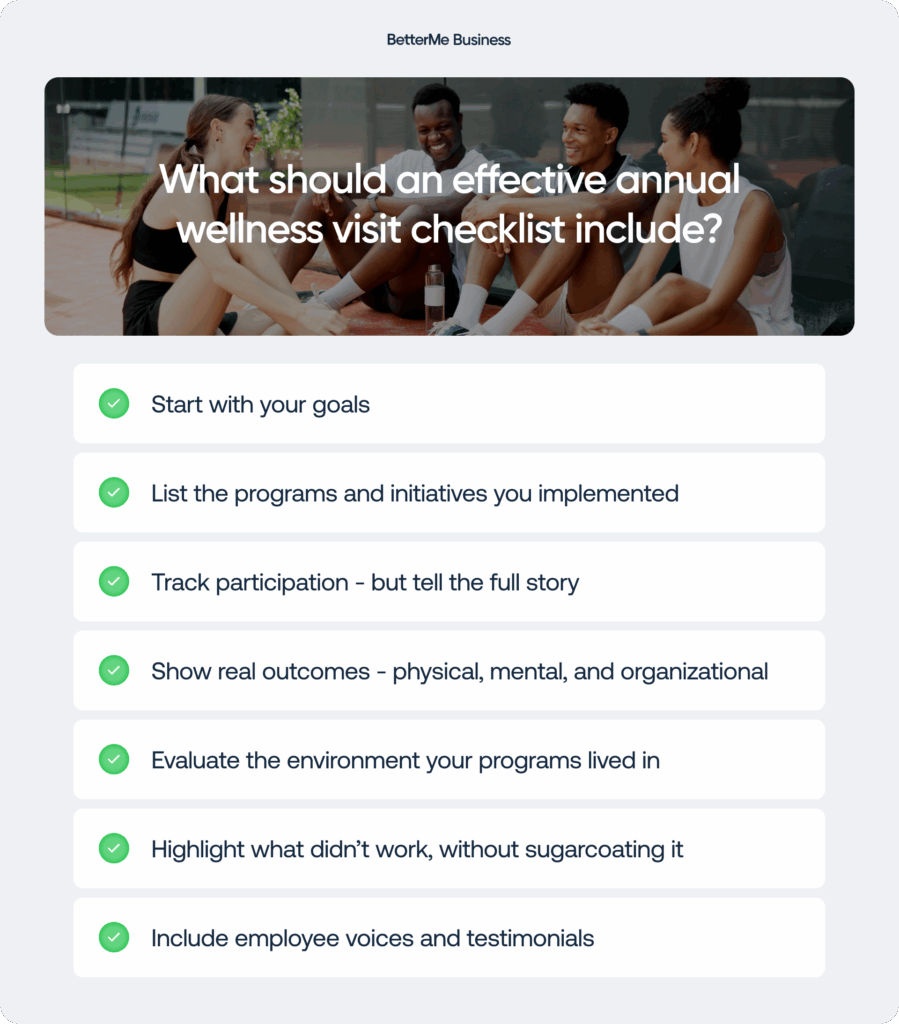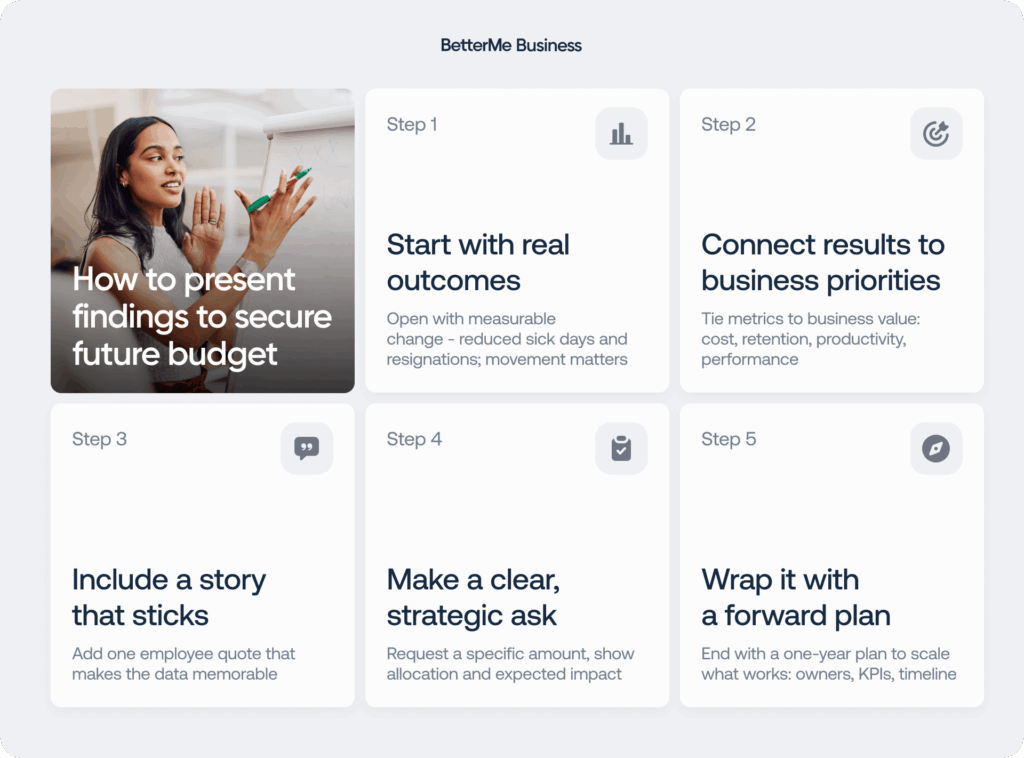As the year wraps up, HR teams everywhere are busy pulling together reports and trying to show what worked, what didn’t, and where to go next. But if you’re just highlighting surface-level initiatives such as stretch breaks or mood-boosting emails, you could be missing the bigger picture. This is where a good annual wellness checklist comes in. It helps you go beyond the surface and really understand the impact of your wellness efforts.
This kind of checklist isn’t just about checking boxes or meeting requirements, it’s your chance to take a deeper look at how well your wellness programs actually supported your people and your company. Just like doctors use an annual wellness visit to catch problems early and make a plan, HR can use this type of internal check-up to figure out what’s thriving, what needs attention, and how to build a better plan for the year ahead.
In this article, we’ll walk you through a simple, clear template for your year-end wellness report. This isn’t just about looking back, it’s about using what you’ve learned to move forward. And let’s be real, your report doesn’t have to be flawless to be effective.
What Should an Effective Annual Wellness Visit Checklist Include?
An effective wellness checklist is like a mirror. It reflects what you planned, what you delivered, and what kind of change actually happened. It helps you answer not just “What did we do?” but also “Did we make a difference?” And in a time when employee well-being is directly tied to retention, productivity, and healthcare costs, this kind of reflection matters more than ever.
Below are the key components your annual wellness checklist should include. These aren’t just administrative details, they’re guideposts for creating a more strategic and responsive wellness program.
1. Start with Your Goals
Before you dive into numbers or attendance rates, pause and ask yourself: What were we aiming for this year? Maybe your company set a goal to reduce employee burnout, boost preventive care visits, or improve biometric health indicators such as blood pressure and cholesterol levels. Maybe it was about fostering connection in remote teams or improving energy levels through better sleep habits.
Whatever the objectives were, they need to be stated clearly at the top of your checklist. Goals give your data context. Without them, even a highly active year can feel directionless. And if your goals changed mid-year, which happens in most organizations, acknowledging that is part of an honest and agile reporting process.
2. List the Programs and Initiatives You Implemented
Now that your goals are clear, move into what you actually rolled out to meet them. Instead of just naming activities (such as a resilience webinar or a healthy eating challenge), describe the intention behind them. For example, was your digital nutrition program meant to reduce metabolic risk? Was your mindfulness app rollout aimed at improving sleep and focus during work hours?
This step is about showing intentionality. Leadership is far more likely to invest in future wellness programs when they see that you weren’t just throwing things at the wall – you were addressing real needs with a purposeful plan.
3. Track Participation – But Tell the Full Story
Participation numbers are helpful, but they’re only half the story. High sign-up rates look great, but they don’t always translate into engagement or behavior change. So yes, you should include how many employees registered for each initiative. But you should also track how many completed them, how many participated in more than one event, and what the retention looked like over time.
Segmenting this data by location, team, role, or even demographic can uncover hidden trends. Perhaps your wellness coaching had strong uptake in corporate offices but little traction among hourly staff, or perhaps engagement was high among new hires but lower among senior employees. These patterns can help you refine your approach moving forward.
BetterMe has excellent tools for your business all in one place: a personalized approach to health and wellness, 1,500 workouts for every fitness level, a variety of meal plans and trackers to satisfy any dietary needs, mental health guides, and employer support. Discover all the options now!
4. Show Real Outcomes – Physical, Mental, And Organizational
This is where the checklist goes from nice-to-have to genuinely valuable. Did biometric screenings show improvement in key health indicators? Did more employees complete their annual wellness check-up this year than last? Were absenteeism or health claims lower in departments with higher wellness engagement?
Go beyond physical health when possible. If your post-program surveys show improved sleep, reduced stress, or higher energy levels, include those insights. These softer metrics are often more closely tied to employee experience and productivity than even traditional biometrics. And if your organization uses wearable data or mobile health apps, those can provide a goldmine of trends on activity levels, sleep, or recovery over time.
5. Evaluate the Environment Your Programs Lived in
A wellness program doesn’t exist in a vacuum. Even great initiatives can fail if the surrounding environment doesn’t support them. For example, promoting hydration won’t help much if employees don’t have easy access to clean water. Encouraging stress reduction falls flat if workloads are unreasonable or PTO is frowned upon.
Use your checklist to include observations, or better yet, employee feedback about environmental supports and barriers. Did managers promote healthy behaviors or unintentionally undermine them? Were wellness efforts supported by company culture, or were they seen as “nice extras”? Evaluating this context helps you spot structural obstacles that may be limiting your program’s impact.
6. Highlight What Didn’t Work, Without Sugarcoating It
This is one of the most underused sections of any wellness report, but it’s where some of the most valuable insights come from. Not every program is going to be a hit, and that’s okay. What matters is whether or not you learned something from it.
If your wellness newsletter had low open rates, or your yoga partnership saw minimal attendance, don’t bury the data – analyze it. Maybe the timing was off. Maybe the format didn’t match how employees prefer to engage. Maybe the topic wasn’t aligned with what they truly needed. Acknowledging misses positions your wellness team as thoughtful, honest, and data-informed, not just promotional.
7. Include Employee Voices and Testimonials
Numbers carry weight, but stories create connection. Add direct quotes from employees who benefited from a wellness initiative – someone who managed to sleep through the night for the first time in months, or someone who finally found a way to balance work and stress through coaching or mindfulness.
These stories humanize your report. They show that your efforts aren’t just about metrics, they’re about people. And when decision-makers read real experiences alongside your data, it helps them see the full impact of the wellness program.
When your annual wellness checklist includes these elements, it becomes more than a document – it becomes a roadmap. It shows where you’ve been, what worked, what needs to change, and what you’re building toward. And no, you don’t need perfect data for every section. What matters most is that you’re paying attention, learning, and moving forward with intention.
Read more: 8 Employee Benefit Trends to Look out for in 2026
How Can HR Quantify Wellness Program ROI?
Wellness programs aren’t just about doing the “right thing” anymore, they’re also about proving that what you’re doing actually works. And when budgets are tight or leadership is asking tough questions, being able to clearly show return on investment (ROI) is what makes wellness go from “optional” to essential.
But here’s the kicker: measuring ROI in wellness isn’t always straightforward. You’re not always dealing with neat profit margins or clear revenue drivers. Sometimes the impact is softer, such as reduced stress or better team morale. Other times, the data is buried in places such as healthcare claims or employee retention reports. Still, there are smart, credible ways to show the value of your efforts and your year-end report is the best place to do it.
Here’s how you can start connecting your wellness work to measurable outcomes that leadership will actually care about.
Start with What You Can Measure Right Now
You don’t need a data science team to get started. Start by tracking the basics:
- Participation: How many employees joined a program? Completed it? Came back for more than one?
- Completion rates: Did people stick with longer-term initiatives, like a four-week coaching program or an ongoing fitness challenge?
- Engagement trends: Are certain departments or teams consistently involved? Did engagement grow throughout the year?
Even simple metrics such as these will give you a baseline. And when you pair them with goals from your annual wellness checklist, you can already start to demonstrate progress.
Link Participation to Meaningful Health Outcomes
This is where ROI becomes more convincing. If you have biometric data or access to health screenings, look for shifts over time in things like blood pressure, cholesterol, or BMI improvements. You can also track completion rates for the annual wellness visit, Medicare wellness exam, or other preventive care services.
Then ask: Did the employees who participated in wellness initiatives see better health results than those who didn’t? Even directional trends can make a strong case. If employees who completed a sleep program reported better focus and fewer sick days, that’s powerful evidence of real-world impact.
Use Indirect Indicators to Show Organizational Value
You may not always be able to tie wellness to dollars saved right away, but you can still show it improves key parts of your culture and operations. For example:
- Absenteeism: Did sick days drop in teams with higher wellness engagement?
- Presenteeism: Are employees reporting better energy and focus during the day?
- Turnover rates: Is retention stronger in departments that were more involved in wellness?
You can also use internal surveys to track how wellness efforts have influenced morale, mental health, or feelings of support from the company. If 78% of employees said they felt more cared for by the organization after wellness programs launched, that’s not just a feel-good stat, it’s a culture shift.
Try Assigning Dollar Values Where Possible
If your company tracks healthcare spending or insurance claims, you may be able to show cost savings in more tangible ways. For example:
- Reduced ER visits due to better preventive care
- Fewer mental health claims after launching a coaching or therapy support program
- Lowered medication costs thanks to better chronic condition management
These numbers can sometimes be accessed through your benefits provider or wellness platform. And even if they’re estimates, they help tell the financial side of your story – something the CFO will definitely notice.
Don’t Ignore the Value of Retention and Engagement
Turnover is expensive. Every time someone leaves, it costs thousands of dollars in hiring, onboarding, and lost productivity. If your wellness program helped increase employee loyalty or created a stronger sense of belonging, it’s a huge win, even if you can’t put an exact dollar figure on it.
Use exit interview data, pulse surveys, or even anecdotal feedback to show that employees felt more supported, more energized, or more balanced during their time with the company. These are the kinds of culture drivers that have long-term payoff.
Present Your ROI in a Way Leadership Understands
Finally, remember your audience. When you present ROI to leadership, frame it in terms that matter to them: productivity, healthcare costs, risk reduction, retention, and culture. Use both quantitative and qualitative evidence. A solid bar chart that shows reduced sick days, followed by a direct employee quote about how a mental health workshop changed their routine, hits both sides of the brain and makes your argument far more compelling.
Ultimately, ROI isn’t just about numbers, it’s about showing that wellness programs are a smart, necessary investment in the health of your people and the success of your business. Even if you don’t have perfect data yet, starting somewhere and building over time is what matters most. The more you track, the clearer the picture becomes and the easier it is to protect and grow your wellness budget in the year ahead.
Which Employee Health Metrics Matter Most for Reporting?
When it’s time to build your year-end wellness report, one of the biggest challenges is figuring out what metrics actually matter. Let’s be honest, there’s no shortage of data out there. You’ve got biometric screenings, participation numbers, mental health surveys, app logins, and even hydration reminders, but not every number belongs in your report.
The goal is to focus on metrics that show three things: change, value, and alignment. These are the indicators that not only reflect what happened, but help you tell a story – one that connects your wellness efforts to real outcomes.
Here’s how to choose the right ones.
Start with Preventive Care and Early Action
Preventive health is a simple, measurable place to start. It’s also one of the clearest ways to demonstrate progress. If more employees are completing their annual wellness visit, getting screened, or showing up for vaccinations, it’s a direct result of proactive wellness programming.
Metrics to include may be:
- The percentage of employees who completed a Medicare wellness exam or annual Medicare wellness visit
- Preventive screening rates for things like cholesterol, glucose, or colon cancer
- Participation in flu shot clinics or other seasonal health campaigns
These indicators help catch health risks early and are also easy to compare year over year, which makes them ideal for showing trends in your report.
Capture Mental Well-Being and Daily Energy
Wellness isn’t just physical. In fact, some of the most meaningful improvements may show up in how employees feel: their focus, their stress levels, and their ability to recover from daily challenges.
To capture this, consider using self-reported wellness surveys or data from digital platforms. You could track:
- Changes in stress scores over time
- Sleep quality improvements after a coaching program or mindfulness challenge
- Reported energy or mood levels throughout the workday
These kinds of metrics may not be clinical, but they’re deeply connected to productivity, engagement, and burnout prevention, which makes them highly relevant to leadership.
Don’t Ignore Physical Health Markers
If your organization offers biometric screenings or health risk assessments, aggregate data from these tools can provide insight into the overall health of your workforce.
You’re not looking for individual results here. What matters is population-level trends, such as:
- Changes in the average BMI, blood pressure, or A1C across your employee base
- A decrease in high-risk categories for conditions like diabetes or hypertension
- Positive shifts in cholesterol ratios or waist circumference
Even if improvements are small, it’s a sign that your wellness program may be encouraging better choices, and that’s something worth highlighting.
Use Digital Tools and App Usage as Real-Time Feedback
Today’s wellness platforms give you access to behavioral data that’s both current and specific. If your team is using a wellness app, online coaching, or self-guided programs, track how employees are actually engaging with them.
Look for metrics such as:
- Log-in frequency to your wellness portal or BetterMe-style platform
- Number of completed sessions in a sleep, nutrition, or fitness module
- Participation in digital challenges or team-based wellness initiatives
These numbers are useful as they show engagement in the moment, not just at the end of the quarter.
Segment Your Numbers for Deeper Insights
If you really want to understand what’s working and for who, don’t just stop at the overall average. Slice your data by department, job role, age group, or work setting.
For example:
- Maybe on-site employees are more likely to attend in-person workshops, while remote staff engage better with mobile apps
- Younger employees may gravitate toward mental health resources, while older groups show higher uptake in preventive care
- Night shift teams might be underrepresented entirely, pointing to access or scheduling barriers
This kind of segmented insight helps you fine-tune your approach, which makes sure your wellness strategy reaches everyone, not just the easiest-to-engage groups.
Choosing the right health metrics is about showing movement in the right direction. It’s not about reporting everything. Instead, pick the numbers that reflect your goals, speak to your impact, and help leadership see why wellness deserves continued investment.
Read more: How to Encourage Work-Life Balance During Midsummer Holidays
What Tools Track Participation Across Wellness Initiatives?
It’s one thing to offer a great wellness program, but it’s a completely different thing to know if people are actually using it. This is where tracking tools come in. If you want to make a case for what’s working (and what’s not), you need a way to see how your employees are engaging with your wellness efforts.
Thankfully, you don’t need anything overly fancy. Just the right mix of tools that give you a clear picture of what’s going on.
Start with Your Wellness Platform
If you’re using a digital wellness platform or app, that’s your best starting point. Most of these tools track things such as:
- Who logged in
- What programs they completed
- When people stopped engaging (which is just as important to know)
Let’s say you’re sending out weekly wellness tips for employees or launching a quick hydration challenge. Your platform will tell you how many people interacted with it and how many stuck with it. This kind of data is golden when you’re planning your next move.
Don’t Overlook Your HR or Benefits System
Your HR software may already be collecting helpful data in the background. For example, it can show:
- How many people completed their annual wellness visit
- Who used mental health resources
- Which employees are showing up for preventive care
This type of info doesn’t always come with a nice dashboard, but it’s super useful when you want to tie participation to health outcomes.
Keep It Old School if You Need to
Not everything has to be high-tech. If you’re running in-person activities such as flu shots, lunch-and-learns, or fitness sessions, you can still use a sign-up sheet or attendance tracker. Just make sure the data doesn’t disappear into a folder somewhere. It’s worth logging in a shared system so you can keep everything in one place.
Ask People What They Think
Numbers are great, but sometimes the best feedback is the simple kind. Send a quick survey after a session. Ask what people liked, what didn’t land, and what they’d want to see next. You can do this with just a few questions and it doesn’t have to be complicated.
This is also a great way to check the vibe of seasonal campaigns. If your summer wellness tips went out in July, did anyone actually read them? Did they try anything? A little feedback can help shape your next round.
Bottom line: you don’t need a dozen tools to track wellness participation. Just choose a few that work for your team, check in regularly, and make sure you’re collecting the numbers and using them to get better each time.
How Does Demographic Data Reveal Program Gaps?
You could have great participation numbers in your wellness program and still be missing the mark. Why? Because not all engagement is created equal. Looking at your data through a demographic lens such as age, role, department, or location, can show you who’s truly being reached and who’s flying under the radar.
It’s not just about who showed up, it’s about who didn’t.
Why Demographics Matter
Wellness programs are rarely one-size-fits-all. Different teams, shifts, and age groups experience work and stress in completely different ways. A virtual yoga session may be perfect for your office staff, but completely inaccessible for night shift employees. A nutrition webinar or a seasonal campaign may resonate with new parents, but fall flat with your younger workforce if it’s not tailored.
When you break down your participation data demographically, you stop guessing and start to see the gaps clearly. You learn whether your initiatives are being experienced equally or whether they’re accidentally built for the same audience over and over again.
What to Look for
Here are some smart ways to break down your participation data and look for gaps:
- Job Type: Are desk-based employees overrepresented in your wellness events, while field or frontline workers are barely involved?
- Work Schedule: Are part-time or off-shift workers able to attend your live sessions, or are they consistently missing out?
- Age Brackets: Are younger employees skipping preventive screenings, while older employees are engaging more in things like the annual wellness visit or health coaching?
- Team or Department: Are some departments participating more just because their manager is more wellness-minded? This happens more often than you might think.
Even a quick look at who’s showing up and who’s not can highlight areas where your wellness strategy needs to stretch a little wider.
How to Use This Insight
Spotting a gap isn’t a failure, it’s feedback. If participation is low in a certain group, ask yourself: Was the timing wrong? Was the communication unclear? Was the program relevant to their actual challenges?
Maybe your warehouse team needs physical wellness options built into their schedules. Maybe your remote staff need more mobile-friendly tools. Maybe new hires just aren’t aware of what’s available yet. The solution doesn’t have to be complex, it just has to meet people where they are.
Why It’s Worth the Effort
When you look beyond surface-level numbers and start analyzing who your wellness programs are really reaching, you’re building something more sustainable. You’re making sure wellness isn’t just available, it’s also accessible. This makes your program stronger, more inclusive, and far more likely to deliver real, measurable outcomes across your entire workforce.
What Leadership Needs From Wellness Impact Reports
When it comes to reporting, what leadership really wants is clarity. They don’t need a play-by-play of every wellness activity – they need to know whether your efforts made a difference, and how that ties back to the business.
So how do you give them what they’re looking for? Keep it simple, but strategic.
-
Start With What Mattered
Begin your report with a snapshot: what your wellness goals were at the start of the year and how close you came to hitting them. If your goal was to increase preventive care, show the percentage of employees who completed their annual wellness visit. If you focused on reducing stress, share trends in employee-reported stress levels or mental health resource usage.
-
Show Trends, Not Just Numbers
Executives are used to looking at patterns. Rather than listing dozens of raw metrics, connect the dots. For example, did teams with high wellness participation also report higher engagement scores or fewer sick days? Even if the link isn’t perfect, the correlation will make your case stronger.
-
Make It Visual
Charts and summaries go a long way. A simple bar graph that shows improvement in biometric markers or participation growth quarter-over-quarter can be more impactful than a paragraph of text. Visuals don’t just make reports easier to skim, they also make them more memorable.
-
Finish with Forward Motion
Your report shouldn’t only be about what happened, it should also point toward what’s next. Include a short section on recommendations: where to double down, what to revise, and what employees are still asking for. It signals that your wellness strategy isn’t reactive, it’s evolving.
Leadership doesn’t need fluff, they need proof. And they need to see that you’re thinking like a strategist, not just a coordinator.
BetterMe provides members with tailored plans that are based on their unique physical, psychological, and lifestyle needs and health goals. Start using BetterMe corporate wellness solutions to transform your team and business!
When Should HR Conduct Mid-Year Wellness Check-Ins?
A year is a long time to wait to evaluate what’s working. Mid-year check-ins help you course-correct before problems grow and momentum fades. Think of them like wellness pit stops – quick, focused, and essential for staying on track.
Why Mid-Year Matters
At six months in, you have enough data to evaluate trends but still time to pivot. If participation is lagging or one initiative flopped, you can make changes early rather than reporting failure at year-end. And if something’s working surprisingly well, you may choose to expand it or run a follow-up.
What to Review
Use this time to look at:
- Program participation so far: Who’s engaged and who’s not?
- Budget usage: Are you ahead, behind, or right on track?
- Employee feedback: What are they asking for or quietly ignoring?
- Alignment with goals: Are your KPIs showing any progress?
This doesn’t need to be a full-scale report. A short internal summary or leadership touchpoint is enough to catch red flags and refocus your plan.
Keep It Agile
The goal isn’t perfection, it’s adjustment. Think of your mid-year review as a chance to stay agile, rather than having to reinvent the wheel in December. Programs don’t need to be locked in forever – wellness should flex as your people’s needs shift.
How to Present Findings to Secure a Future Budget
You’ve done the work and gathered the data and now it’s time to show leadership that your wellness program is worth continuing, or even expanding. To secure future funding, your report needs to be clear, focused, and tied directly to business value.
Here’s how to frame your findings to have the biggest impact:
1. Start With Real Outcomes
Open with what actually changed. Were there fewer sick days in teams that engaged with coaching? Less burnout-fuelled resignations? Highlight any progress, even if it’s small. Showing movement matters more than perfection.
2. Connect Results to Business Priorities
Use language that leadership relates to – think cost savings, retention, productivity, and performance. For example, if your program helped reduce absenteeism or increase EAP usage, explain how this affects morale and bottom-line efficiency.
3. Include a Story That Sticks
Add a short employee quote or experience that puts a human face on the numbers. Something like, “After using the wellness app, I finally started sleeping through the night.” Stories like this make data memorable and help drive emotional buy-in.
4. Make a Clear, Strategic Ask
Don’t just say you need more money. Be specific: “With a 15% budget increase, we can launch a digital option for shift workers and expand our mental health resources.” Show exactly what the added investment will support and why it matters.
5. Wrap It with a Forward Plan
End with a brief roadmap for the year ahead: what you’ll keep, what you’ll tweak, and what you want to grow. This shows that your program is adaptive, responsive, and ready to scale.
The Bottom Line
Year-end wellness reporting doesn’t have to be overwhelming – it just has to be intentional. When you track the right metrics, listen to employee feedback, and look at engagement across different groups, you’ll create a report that’s more than just numbers – you’ll create a story. Whether you’re reviewing outcomes, planning next steps, or making the case for more budget, the goal is simple: show how your wellness program is helping people live better and work better. Keep it honest, keep it focused, and use what you’ve learned to build an even stronger year ahead.


















